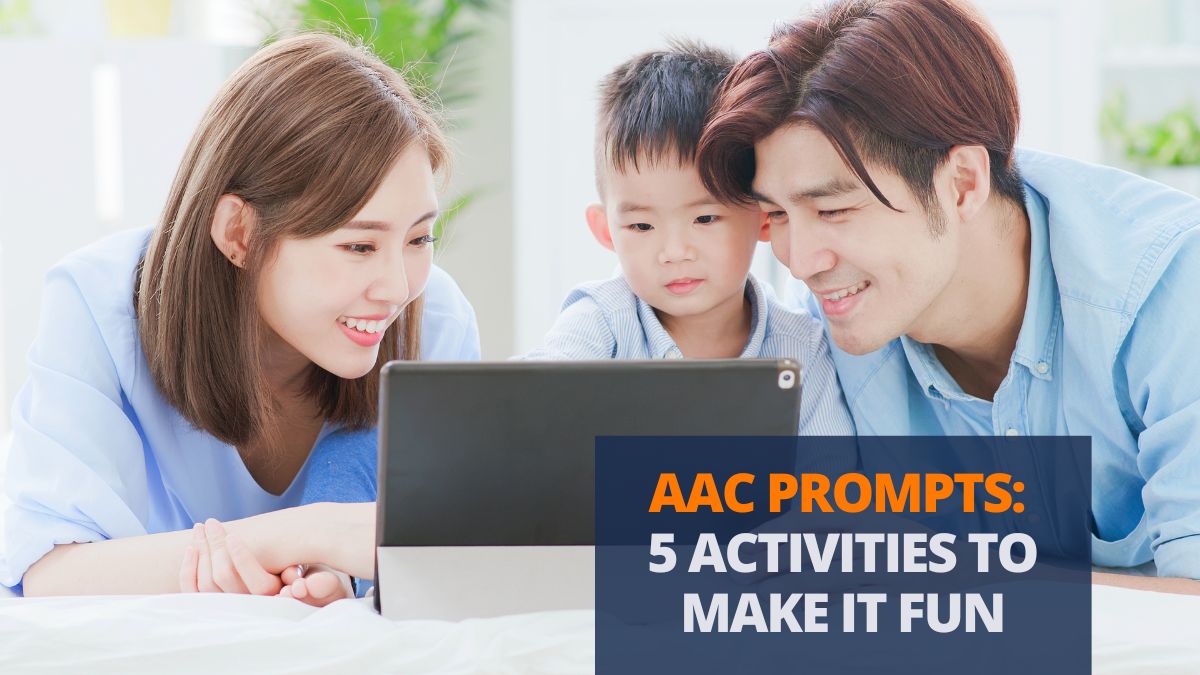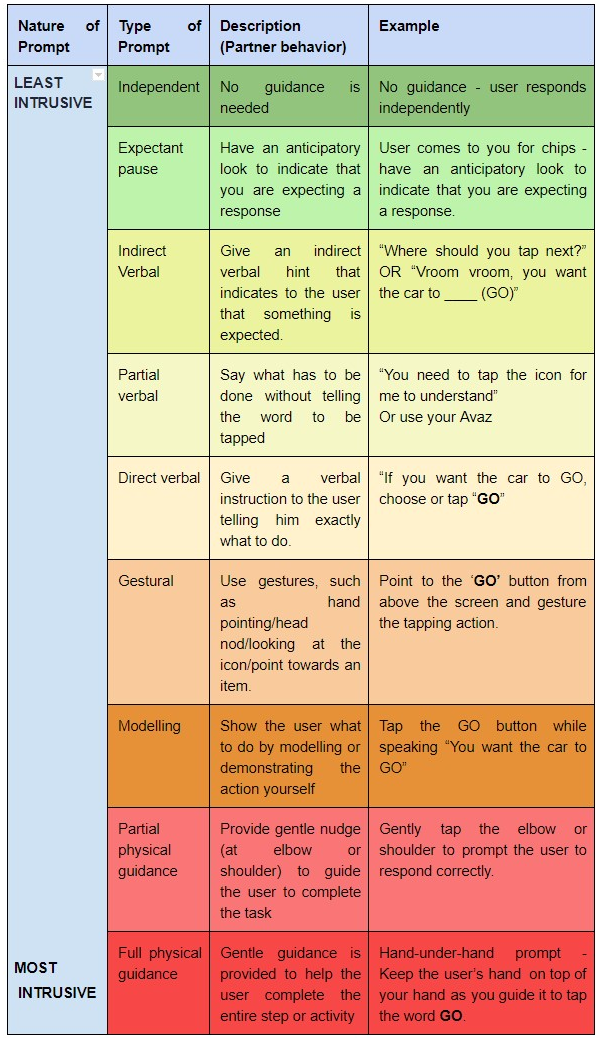Prompt is a cue or instruction that you give a user to help them learn a new skill. There are different types of prompts such as gestural and verbal that you can use to motivate a user to learn and succeed. Although prompts have been proven to be useful in successfully teaching a new concept, fading them is important to avoid prompt dependence. Relying too much on prompts might make communicators not interested in learning the skill and can be a barrier to independent/autonomous communication
Why Fade Prompts ?
Once you are quite confident that the learner can perform the target skill or task with a certain prompt, you can wean the prompts given to them. Fade the prompts gradually, rather than abruptly taking them away.
The benefits of fading prompts are:
- Communicator learning to perform a task independently with adequate support until they need it
- The communicator is encouraged to be an active participant who initiates communication.
- Building agency where communicators are making communication decisions themselves rather than responding to prompts.
- Boosting confidence in expressing what they want, without help from the communication partner. This motivates communicators to continue using their learned skills in various settings and contexts.
How to Fade Prompts?
The outcome of the prompt fading process is unique for each person. In most cases, the prompt fading happens from the most to the least intrusive prompts. It is best to keep a close watch on the AAC learner’s response when the prompt fading has begun. Some of the key points to remember while prompt fading are;
- Note down the response every single time
Irrespective of the level of prompt that is being used, it is best to gradually reduce the frequency of prompting the AAC learner. Look out for the response and the performance of the AAC learner to do a task when there are minimal or no prompts given. If you notice an incorrect response or notice a struggle from the AAC learner, then you can jump back to the earlier level of prompting. Keep a track of every single response from the AAC learner as this helps to understand the AAC learner’s baseline as well as to gauge the outcome of the prompt fading process.
- Pausing for a ‘Response Time’
The powerful, potent pause! Waiting for the learner’s response is so important. It’s best to wait for at least 5 seconds before providing any prompts. Not giving this pause time and giving more prompts only means that the communication partner has denied the opportunity for the AAC learner to respond correctly.


- Use ‘Totally-worth-it’ type reinforcers:
Provide more reinforcers when AAC learner communicates without prompts. Choose reinforcers like their favourite toys or TV time that they won’t mind working hard to get. Reinforce each and every time the AAC learner attempts to communicate independently. This makes them feel confident and motivates them to try their best.
Prompt Fading Example Scenario
Imagine you have been encouraging a learner to request help using their AAC system with full physical prompts which is the most intrusive prompt. Here’s how you can fade prompts for them –
Once you have waited for their response, follow the prompt hierarchy to try other prompts. By following the prompt hierarchy, you are also essentially laying the groundwork for fading prompts.
For example, if the learner does not respond to any of the less intrusive ones, you can tap on the elbow of the learner nudging it towards the AAC system. This is you providing a ‘partial physical prompt’. At this point, you’re not using full physical prompt like you were before. You’re just nudging, directing the learner to use their communication device.
Don’t rush into fading prompts, because this can result in errors. Once you see that they are able to tap ‘help’ with partial physical prompt, you can try modeling as a prompt.
Say, “You can ask help by tapping Help”, and tap ‘Help’ on the AAC system.
And wait.
Watch their response.
If you see an incorrect response, you can go back to the prompt level you used earlier.
Customizing Prompt Fading
You may need to vary the prompt fading procedure according to the needs of the AAC user. All individuals may not follow the same order of prompt fading. The customization of the prompt fading process can be decided/predicted ONLY based on their response to each prompt for a target skill/task.
The key is to observe how the learner is responding to the prompts and fade them accordingly. Gradually try each prompt and record their responses.
You should continue to use an expectant pause for their response every time. Just raise your eyebrows to indicate that you are expecting a response. This is so important because it gives the learner time to construct a response. You are also letting them know that what they have to say matters. This instils confidence in them and encourages them to communicate more.
WRITTEN BY
Sujatha.S, M.A.S.L.P
Audiologist & Speech – Language – Swallowing Therapist
I have 8 years of experience functioning in various set-ups like special schools, private hospitals, family-based & community-based rehabilitation. I get immense pleasure in providing & seeing success in custom-made intervention programs for individuals with hearing, speech-language and swallowing issues.


References:
https://praacticalaac.org/praactical/reducing-prompt dependence-in-aac-learners-5-things-to-try/
https://www.ncbi.nlm.nih.gov/pmc/articles/PMC2635569/pdf/nihms71051.pdf
https://www.ncbi.nlm.nih.gov/pmc/articles/PMC6464758/pdf/CD012490.pdf
https://theautismhelper.com/procedures-prompt-fading/
http://knappcenter.org/wp-content/uploads/2017/05/Workshop-2_Utilizing-Prompting-and-Prompt-Fading-to-Teach-Skills.pdf



